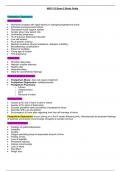Other
NUR113 Exam 2 Study Guide
- Course
- NUR 113 (NUR113)
- Institution
- Fayetteville Technical Community College
Exam 2 study guide for NUR 113 (fall semester). Study guide has all relevant exam content and topics with detailed information pertaining to each topic.
[Show more]



